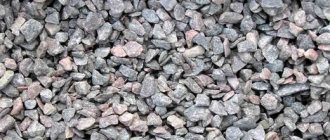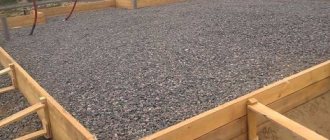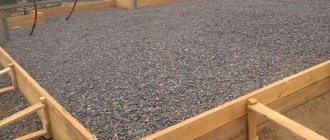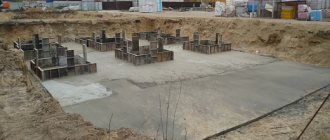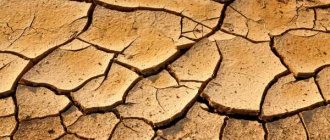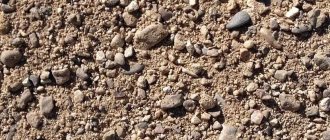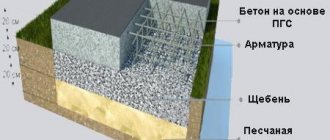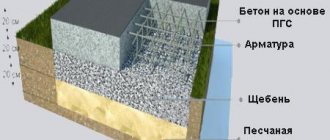Added by: Ksenia Zubkova June 22
When planning the construction of a house, they work out all the aspects, including deciding how the cushion under the foundation will be arranged. Without it, the foundation will not be able to withstand the loads, and the building will only last for a short time. The pillow under the base of the house must consist of a specific material, spread in a layer of a certain thickness.
Purpose and thickness of the foundation cushion
The foundation structure is always exposed to the harmful effects of the environment, which can cause it to become less durable. Only the owner who took care of installing the correct cushion under the foundation can avoid weakening the foundation of the house. It is this that makes the surface below the base stable and level.
The pillow is located at the very bottom of the created “pie”
In order for this pillow to perform its task without fail, it must be covered in a thick layer. The thickness of the layer depends on:
- type of foundation;
- dimensions and weight of the structure;
- types of soil on which the building is planned to be erected;
- depth of freezing of the ground;
- proximity of groundwater to the top layer of soil.
Also, the density of the pillow is influenced by the material from which it will be constructed. These raw materials can be sand, crushed stone and gravel mixed with sand.
Sand for the base of the house
Sand cushions are popular because they protect the foundation well from deformation. And the sand bedding blocks access to groundwater to the base of the house.
Most often, sand is poured under the foundation
In order for the foundation cushion to function properly, it must be covered with a thick layer of material. The optimal thickness of each layer of sand is 20 cm.
The sand cushion is located above the ground and below the concrete foundation reinforced with reinforcement
The raw materials used must be medium or coarse-grained. When planning to lay the next layer of such sand, the previous layer of material should be pressed and sprinkled with water.
Moisturizing will make the cushion dense and give it a unique ability to support the weight of the foundation and the structure standing on it.
Video: when and how to make a sand pillow
Crushed stone for the foundation
A crushed stone cushion is chosen when they want to provide the foundation with better protection from destruction. Crushed stone is stronger than sand and therefore is actively used as bedding under the base of a building whose walls are erected from heavy material.
The crushed stone cushion is popular because it is significantly denser than sand
It is customary to pour crushed stone with a size of 2 to 4 cm under the foundation. This diameter of the stones is considered average and allows you to achieve the desired qualities from the pillow: density, evenness and adhesion ability.
The crushed stone cushion must be laid on a thin layer of sand. A 10 cm layer, consisting of compacted and moistened building materials, is needed as a bedding that will prevent the stones from being pressed into the ground.
The crushed stone cushion, laid on top of the sand, is poured in a layer of 10 cm. But if the construction is heavy, then it is recommended to increase the thickness of the layer of stones to 20 cm. The layer of stones is well compacted, thereby improving the quality of the bedding, which should not sag under the pressure of the foundation.
It is recommended to lay the crushed stone cushion from stones with a fraction of 30–50 mm
Special requirements are imposed not only on the thickness, but also on the width of the pillow. A layer of crushed stone will flawlessly fulfill its task of ensuring the stability of the structure if it is 30 cm wider than the base of the house.
In order for the foundation to be built on a crushed stone bed without problems, the layer of stones should be laid perfectly evenly. Therefore, the zero level is measured in the ground using pegs and when filling the hole with crushed stone, they are guided by it.
After filling the dug pit with building material, take a level and check whether there is a height difference between several points of the created crushed stone cushion.
Video: example of creating a cushion for a foundation made of crushed stone
A mixture of sand and gravel for the base of the building
They resort to creating a pillow that consists of sand and gravel, wanting to make the pillow durable and at the same time save on the purchase of construction raw materials.
The sand and gravel cushion is laid in layers of different thicknesses. The main thing is that this parameter is at least 5 cm. As a result of filling the hole with several layers of sand and gravel, you should get a cushion 25 cm thick.
The thickness of the sand and gravel cushion is usually 30 cm
Typically, the first layer of sand and gravel cushion is created from limestone fragments, which helps to strengthen the strength of the embankment. The second layer, as a rule, consists of coarse river sand, which is compacted and watered. After this, 15–20 cm of gravel, pressed with a vibrating plate, is poured into the pit.
Sand is poured on top of several layers of building materials. The optimal thickness of the last layer of the cushion is 20 cm. The top layer of the embankment must be sprinkled with water so that it settles on the gravel.
Video: laying a gravel cushion under a columnar foundation
Is it necessary?
Some private developers, for whom cost-effective construction is important, believe that it is not necessary to lay a cushion under the foundation.
They believe that if the house is built on dense soil, they can do without it. In fact, it is a mandatory element of the strip foundation, because:
- Ensures uniform distribution of the impact of construction on the soil.
- Prevents foundation subsidence.
- Acts as an additional barrier between the base of the building and groundwater.
Is a sand cushion needed for, for example, a strip foundation on clay? A sand or crushed stone cushion is needed during the construction of any object, regardless of:
- soil quality,
- dimensions of the building,
- foundation depths,
- other factors.
It provides stability and strength to the base. At the same time, it protects it from moisture and compensates for soil movements, keeping the base of the building motionless.
Usually the pillow is made of sand. When leveling the bottom of the trench, sand is also used, but this is not a cushion, but simply an auxiliary layer of 2-3 centimeters. In addition to sand, crushed stone or concrete mortar is used for embankment.
Sand pillows are the most economical . They are used in the budget construction of small buildings. You need to purchase coarse sand, otherwise the base will not be hard enough.
It is necessary to pour sand in layers, carefully compacting each layer 10 cm using water. Sand mounds are made from 20 to 40 cm in height. The surface must be perfectly leveled.
Under a house on soft soil, a cushion of sand alone may not be effective. Crushed stone is added to it, which makes the base resistant to shrinkage .
The mixed base is stronger, more durable, and better protects against moisture. When building private cottages, it is recommended to use such combined pillows.
Crushed stone and sand can be mixed . But it is better to pour the materials in layers - first a layer of sand, then crushed stone. The layers should be up to 20 cm. The filled sand must be carefully compacted and leveled. After pouring crushed stone, you need to walk over it and also level it, check whether voids have formed.
The pillow can only consist of crushed stone. A gravel or granite variety is used. Usually gravel is purchased because it is cheaper and more convenient to use. Crushed stone is more stable than sand. It absorbs less water and has a longer service life. It is used in the construction of two and three-story cottages.
There is also a concrete option . In fact, the concrete subbase is an additional element of the foundation. It is installed on top of a fairly high sand cushion (up to 50 cm). Concrete is a thin monolithic reinforced layer of concrete on which the main part of the foundation is built - formwork, reinforcement cage, pouring concrete.
Pillow laying technology
In addition to sand, crushed stone or gravel, to create a cushion for the foundation, you need to purchase geotextiles. This material will serve as a barrier to the penetration of groundwater into the embankment, which can turn the cushion into ordinary soil.
Creating a pillow for the base of the house is a step-by-step process:
- A pit is dug in the ground and the bottom is thoroughly compacted.
The bottom of the dug hole must be perfectly level
- The bottom and walls of the resulting pit are covered with geotextiles.
It is desirable that the geotextile fabric be large and cover the walls of the pit - The pit is filled with one layer (if only sand is used) or several layers of construction raw materials (in the case of a crushed stone or sand-gravel cushion).
A vibrating plate is passed over the embankment of each material several times, compacting the construction raw materials. In this case, the pillow is created from sand and crushed stone - The “layered cake” is covered with geotextiles.
Concrete base
The most expensive and reliable type of underlying layer. A concrete pad can even be used for the foundations of apartment buildings. The technology for its implementation is quite simple and accessible for independent work. The process consists of several stages:
- leveling the bottom of the excavation;
- adding crushed stone with a layer of 10 cm and tamping;
- installation of formwork to the height according to the project;
- waterproofing flooring;
- installation of reinforcement;
- pouring concrete mortar;
- gaining monolith design strength;
- dismantling formwork.
To ensure strong adhesion of the base to the foundation, steel rods protruding above the surface are installed in the cushion. They serve as connecting anchors, maximizing the strength of the underground structure.
Arranging a concrete cushion
A concrete pad under the foundation of a house, compared to a sand and crushed stone embankment, has an increased load-bearing capacity, but will require significant financial costs.
The recommended thickness of concrete as a cushion for the foundation is 30 cm. The structure made of a mixture of cement and sand should extend beyond the base of the house by 15 cm on each side. So, if the width of the foundation is 70 cm, then liquid concrete is poured into a hole measuring 1 meter.
The concrete pad is arranged in a special way:
- A hole is dug in the ground.
The area below it is leveled and covered with crushed stone, as a result of which a 10 cm thick layer is formed at the bottom of the pit. The resulting layer of material is pressed with a vibrating plate and covered with plastic film, which will not allow the concrete mixture to leak. Crushed stone is used as the first layer of concrete pad - In a pit, formwork is constructed from boards knocked together, along which reinforcement is placed - a mesh with 20 cm cells, made of metal rods with a diameter of 8 mm.
The height of the auxiliary wooden structure must match the thickness of the concrete pad, which cannot be more than 30 cm. Reinforcing mesh is needed to strengthen the concrete pad - The pit is filled with liquid concrete grade M100 or M150.
Then this construction raw material is pressed with an internal vibrator. Hardened concrete also needs tamping in the same way as crushed stone
Video: stages of creating a concrete pad
So, in places where the ground is relatively stable, a cushion of sand is created. And in areas where the soil freezes strongly and groundwater flows close to the soil surface, a cushion of crushed stone or concrete is installed. Placing certain building materials under the foundation of the house in accordance with the requirements will ensure that the building will stand for many years.
I am a philologist by training and have been writing texts for more than 5 years.
There are a lot of textbooks, video tutorials and step-by-step instructions for building a foundation.
And a lot of recommendations from experts who broadcast from television screens about how to properly dig a trench for the foundation, and why it is better to use concrete from their company.
But for some reason, the topic of proper organization of the sand cushion during the construction of the base of the structure is extremely rarely addressed.
We decided to fill this gap and tell you why it is needed and in what cases it can be neglected. Let's touch on the topic of making pillows for different types of foundations and materials for this.
conclusions
A foundation base made of sand and crushed stone is an objectively necessary part of construction , designed to extend the operational period of the structure, without additional costs at this stage. Sand can be used as a material, a cheaper, more accessible material that is excellent for small structures. Crushed stone, especially granite, can “bear” more serious loads and is suitable for large buildings, but is more expensive and not available everywhere. Each specific construction case will determine the choice of material, and not only according to economic parameters.
Why do you need a sand and gravel cushion?
To talk about the need for its construction, you must first of all know what the sand cushion is for.
There are several reasons for its design:
- It serves to level the bottom of the trench. High-quality leveling is extremely important for the further construction of the foundation.
- It resists compression of the soil under the base of the structure, and correctly distributes the weight of the entire structure.
- A properly made cushion under the foundation prevents it from freezing.
- The sand layer can act as drainage and remove rain or melt water from the base of the building.
- The correct sand layer breaks the capillary bridge and resists the penetration of moisture from the soil into the base of the building.
- It serves as a “shock absorber” for the foundation during soil heaving.
Based on the above, it is necessary to make a sand cushion for all types of bases.
A little theory first
Why do you need a sand cushion under the foundation? Whose whim is this? No, this is not at all someone’s idea that generations of builders mindlessly repeat. Any structure puts pressure on the soil. And the larger it is, the greater its weight. The soil, as is known, has a rather “mobile” character. It becomes especially noticeable in the spring, when the snow melts, and in the fall, when the seasonal rains begin. Groundwater rises closer to the surface and the soil can sag under the weight of the building. It is not for nothing that the topping under the foundation is called a pillow. It compensates for ground displacements and does not allow the structure to “play” too noticeably. At the same time, it allows water to pass through, preventing it from accumulating in the ground under the foundation.
But not only melt water and rain are dangerous. When the soil freezes deeply in severe frosts, movements also occur that destroy the foundation. That's what this pillow is for.
In addition, sand, as well as small crushed stone, help level the bottom of the trench for the foundation. This is important if ready-made concrete blocks or slabs are used to lay the foundation.
Materials for creating a pillow
Even judging by the name, a “sand pillow” is made from sand, but not just any sand, as it might seem, but coarse-grained sand.
The ideal option is coarse gravelly sand. It is “coarse” sand or medium-fraction river sand that will resist possible shrinkage of the structure.
But many experts recommend using a sand-gravel mixture to create a layer, citing better drainage and compensation properties.
In fact, for the compensation layer you can use any less heaving material that resists compression well.
It is much more important to protect this layer from the influence of moisture during seasonal increases in groundwater levels. To do this, you need to prevent the soil from mixing with the sand cushion by laying a layer of geotextile between them.
Device and thickness
It is individual for each project, and for correct calculation several factors should be taken into account:
- What type of foundation is planned to be used?
- Dimensions and weight of the building.
- The soil on which the building is erected.
- Soil freezing depth.
- Presence and proximity of groundwater to the soil surface.
Many publications say that the thicker the sand layer, the better it resists various deformations of the structure. Experts strongly disagree with this opinion.
Important! The maximum thickness of the sand cushion for strip foundations is three strip widths.
For strip foundation
Strip foundation is the most common type of foundation used in the construction of low-rise buildings.
The thickness of the sand cushion under this type of foundation is determined based on the specific construction conditions. But for a small building, as a rule, they take an average value of 15-25 cm.
Experts recommend that the width of the sand cushion be 10-20 cm larger than the width of the tape.
A layer is made between the strip foundation and the soil as follows: the recommended layer of sand is poured onto the bottom of the trench and carefully leveled. After which the sand is moderately moistened with water for better shrinkage and subsequent compaction.
The process of compacting the layer is best done using a vibrating plate, but this can also be done with improvised means.
The degree of readiness can be determined as follows: there should be no traces of shoes left on the surface after the passage of an adult. After compaction, the stage of carefully leveling the pillow and laying a layer of waterproofing on it follows.
For a monolithic foundation
The arrangement of a sand layer under such a foundation is done in the same way as in a strip foundation, but over the entire area of the pit.
To make the correct layer for this type of foundation you need:
- Carefully level the bottom of the pit.
- Pour gravel or crushed stone 10-15 cm thick. This material serves to compensate for the low density of the soil and its heaving.
- A layer of sand is poured onto the crushed stone. For a small bathhouse or small cottage, a layer of 10 cm is enough. Sand will help to evenly distribute the load from the building on the soil.
- The next stage of the device will be thorough compaction. For this, experts recommend using a vibrating plate.
Before laying a foundation on it, the sand layer must be leveled and covered with a layer of waterproofing to prevent moisture from entering the foundation of the building.
For columnar and pile foundations
A columnar foundation also requires a sand layer underneath, or rather a sand and gravel layer.
The principle of its construction is the same as for other types of building foundations: first, a layer of gravel or crushed stone is poured, after which sand is poured, moistened and thoroughly compacted with a hand tamper.
For foundations of this type, the sand and gravel layer should be 20-30 cm thick. In addition, it should be 10-20 cm wider than the pillar on each side.
Afterwards, roofing felt or polyethylene is placed on the surface of the pillow to prevent water from being poured into it from being poured into the concrete.
Possible solutions
The simplest base consists of sand. Such a pillow is applicable for the foundation of a one-story building made of materials that weigh lighter than reinforced concrete: log house, bathhouse, garage, outbuilding. In addition, with the help of such a base, loose soil is compacted.
Consumable raw materials can be extracted from a river or quarry. In terms of quantity, it must be taken into account that about 15% must be added for tamping. Among the advantages of such a solution, the following points stand out:
- natural moisture removal;
- groundwater absorption;
- additional thermal insulation;
- shock absorption during soil heaving;
- easy compaction.
The thickness of the cushion is selected based on the load, soil conditions and the width of the foundation. Thus, a compacted layer of 150 mm is sufficient under the slab, and for the pillars of pile-grillage foundations, holes are dug with a triple increase in diameter to a depth under the cushion of up to 30 cm.
In the case of clay soil, the thickness of the subbase can reach 0.5 m. In this case, it is better to arrange it in 3 passes with intermediate wetting and compaction. If the groundwater is located high, it is recommended to additionally lay waterproofing material on both sides of the sand cushion: geotextiles, roofing felt.
Geotextile for foundation
Gravel bed
To construct the pillow, crushed stone, granite, but not limestone stone are used because of its low hardness. A substrate made of coarse filler is suitable for houses with 2-3 floors, if the grain fraction is 20-40 mm and the strength corresponds to M1200.
Additional waterproofing of the cushion increases the cost of the sub-base, but it is justified by ensuring the protection of the foundation. If granite is used, then rolled materials are applicable. In other cases, the stone has sharp edges, so only liquid bitumen-based compositions are acceptable.
Before the gravel, a small layer of sand cushion is laid under the foundation up to 15 cm (if it is not a sandy soil type). When installing a recessed cushion, compaction is carried out in stages with a thickness of 25-30 cm. It is important to monitor the extension beyond the perimeter of the future structure within 20 cm, as well as the horizontality of the coating.
Large gravel
The advantages of such a basis are the following:
- the point load is reduced, as it spreads throughout the entire area;
- the impact of negative temperatures is mitigated;
- moisture removal from the foundation is ensured.
The construction of a stone substrate is unacceptable in conditions of close proximity to groundwater. Especially if the building will place a large load on the foundation (above 3 floors).
PGS pillow
First, geotextiles are laid with a margin for the end edges. Then a layer of sand is compacted to 15 cm, followed by covering with the same cloth. To avoid damaging it with gravel, add sand. Finally, with periodic wetting, sand is poured in and compacted until a strong crust is formed. This type of foundation is relevant for weak soil, clay soil and light buildings: bathhouse, garage, outbuilding.
ASG substrate
Regarding the composition of the mixture in the continuous version, the grains of the coarse fraction make up 60% of the total mass. In the case of a strip foundation, the thickness should be equal to three areas of the base of the supporting structure. The width on sandy soil is 0.5-0.6 m, on loamy or sandy loam up to 0.8 m. A pillow similar to the one located under the foundation is placed under the cellar.
Concrete base
The monolithic base is considered the most durable, as it has a high load-bearing capacity. Application is acceptable for any soil and high-rise buildings and industrial complexes. Such a pillow is otherwise designated as FL (strip foundation). The density of such a base can reach 2.5 t/cubic meter. m.
The technology for constructing a concrete pad is represented by the following steps:
- gravel is compacted in a layer of up to 15 cm;
- a reinforcing mesh with cells up to 20*20 cm is assembled from rods with a diameter of up to 1.2 mm;
- formwork is installed;
- a ready-made cement-based mortar is poured, followed by vibration compaction;
- the surface of the screed is leveled.
At the same time, geotextiles or roofing felt are also laid, sand is poured and compacted. The outer surface of the substructure must correspond to the lower boundary of the building foundation.
Concrete base
Concrete blocks
Another option for constructing a monolithic cushion involves the use of factory-prepared concrete blocks. They are used for building houses on dry and wet soil with a lower operating temperature of -40 degrees Celsius. Laying in regions with unstable soil and seismic activity is also permissible.
Concrete blocks are classified according to their load-bearing capacity (in kgf/sq.cm.):
- 1 – up to 1.5;
- 2 – up to 2.5;
- 3 – up to 3.5;
- 4 – up to 4.5.
The marking contains designations of vapor permeability:
- P – low;
- N – normal;
- O – with a minimum indicator.
The dimensions of the FL (strip foundation) are regulated by the state standard and are presented in a wide range. This allows you to choose an option for almost any structure. Due to the large weight of the blocks, it is necessary to rent lifting equipment, so this solution is not common in the private sector, but is relevant for urban planning. This is a reliable option, fast, durable and does a great job of distributing the load.
Concrete block base
The technological process of installing the substrate includes waterproofing protection of the trench. Its size must exceed the width of the blocks. Next, the river sand is compacted and leveled, but only soil compaction is allowed. After it dries, the blocks are laid. The gaps between the workpieces are filled with concrete mortar. Next, you can begin building a house with the installation of wall slabs in the middle part of the substrate.
What else can a pillow be made from?
For a foundation cushion, you can use almost any material that will have good compression resistance.
Sometimes, for the construction of large and heavy buildings, layers made of concrete are used. They are quite reliable and have great strength, and they can be used for buildings of any number of floors and weight.
To arrange a concrete pad you need:
- Pour gravel into the trench in a layer of no more than 10 cm and compact it.
- Install formwork, the height of which should not exceed 30 cm.
- To increase the strength of the concrete pad, reinforce it. Rubble or reinforcing rods can be used as a reinforcing material.
- Pour the concrete mixture into the prepared trench.
- Carefully distribute the concrete along the entire perimeter and compact it with a construction vibrator.
- After the concrete pad has dried, place a layer of waterproofing on it.
The construction of a sand cushion is an important step in the construction of the foundation. By following the simple rules described above, the foundation will be strong, reliable and will last for many years.
Everyone knows that the support of a house is the foundation. If the underground part is done correctly, the structure will last a long time. During operation, cracks will not appear on its façade, the windows will not warp, and the base will not collapse. The foundation pad is the first layer of foundation for almost every building. It is considered an important functional component, and its design is subject to certain rules.
Why do you need a pillow?
It would seem, why are foundation cushions needed if there is a dense layer of soil underneath as a base? But it turns out that it is thanks to them:
- uniform redistribution of incoming loads on the ground is maintained;
- point pressure decreases;
- the impact of frost heaving forces on underground structures is minimized;
- the bottom of the recess is leveled, and you can do this yourself;
- the horizontal position of the foundation base is guaranteed;
- groundwater level decreases, and rain and melt water is removed from the foundation;
- the stability of the position of the entire structure is ensured;
- shrinkage of various origins is minimized.
A stable foundation requires that the foundation pad be properly sized and adequately compacted and leveled. Its width should be greater than the width of the foundation sole, and its height should be selected taking into account:
- soil freezing depth;
- groundwater level;
- approximate magnitude of permanent and temporary loads;
- geological conditions.
The backfill under the foundation is a kind of ballast that protects the structure from contact with the soil and from seasonal soil movements.
Often a foundation cushion replaces an unsuitable or weak soil layer. In this case, it is removed, and coarse sand is added in its place. To prevent it from washing out or silting, when the groundwater level is high, geotextiles are placed in the excavation.
Materials
When constructing foundation cushions you can use:
- river and quarry sand;
- crushed stone and gravel;
- concrete solution.
Clarifications on the composition and size of the underlying layer are given in the design documentation. As a rule, it takes into account the availability of materials by region and their reasonable cost. But the main argument, nevertheless, remains geological conditions. For example, for soft soils, a gravel-sand cushion under the foundation is laid in the following proportions:
- 40% sand;
- 60% crushed stone or gravel.
Some craftsmen offer the construction of a clay foundation cushion. They claim that the leveling layer will perform a waterproofing function. Of course, clay can protect concrete from capillary suction of water. But this soil is heaving, so when it freezes it increases in volume and begins to put pressure on the underground structure. From this it follows that the judgment that clay can be used for the foundation is absolutely incorrect.
sand cushion
It is better to make the underlying layer with your own hands from sand, since the material is quite available in many regions of the country. Inexperienced developers often have questions about what kind of sand is needed for the foundation and cushion - river or quarry, and what fraction of the grains should be.
We should start with the difference between river sand and quarry sand. The first is considered much cleaner, since the natural dislocation of the material and the technological features of extraction imply the absence of foreign particles in the composition. There are no clay inclusions that are too dangerous for the foundation structure. When mixing the concrete mixture and constructing a cushion for the foundation , it is better to use river sand or washed quarry sand, which will be somewhat cheaper.
Quarry sand is extracted in large quantities from open-pit mines. That is why it contains many different impurities, such as clay, large stones and dust particles. Without additional processing, it is used only in some cases, for example, when laying roads.
It is not recommended to use dirty quarry sand for the foundation and cushion, since the presence of even a small amount of harmful inclusions in it can adversely affect the stability of the underground part of the house and its durability. Why risk a one-time savings when there is a better quality alternative?
You can distinguish river bulk material from clean quarry sand by the appearance of the grains. You just need to look at them through a magnifying glass. In the first case, the particles will be round, and in the second - with sharp edges.
Sand for the foundation and pillows is chosen from large fractions.
As mentioned above, making a sand cushion for the foundation with your own hands will not be difficult at all. To do this you will need the material itself, a tamper and water. If the building area is large, it would be better to use a special vibrating plate or roller. And when compacting the underlying layer in a trench, you can use proven old-fashioned tools, for example, a log with a cross handle.
The sand cushion under the strip foundation or concrete slab is filled in layers. Each layer is leveled, moistened and thoroughly compacted. Abundant watering helps to better compact the sand and ensure maximum density of the base. When the groundwater level is high, crushed stone is added to the bottom of the trench. It takes on the functions of a drainage layer. In its absence, the foundation of the house will sooner or later be washed away.
Experts recommend making a foundation cushion from sand in cases where:
- a one-story house is being built;
- Light materials are used for the ground part of the structure;
- groundwater lies at great depths.
Even before starting work, you should decide on the thickness of the sand cushion for the foundation. As a rule, it is 10-20 cm, but when installing a base under a concrete slab or when replacing weak soil, the size can increase to 50-80 cm. For a strip structure, the maximum height of the underlying layer is limited by the triple thickness of the strip. As for the width of the pillow, it should be 20-25 cm larger than the same size of the sole or foundation slab.
Crushed stone bedding
The crushed stone cushion under the foundation is considered stronger than the previous version of the foundation. You can also do it yourself. At the initial stage, the bottom of the excavation is covered with a 10-15 cm layer of coarse sand, after which it is leveled and thoroughly compacted with moisture.
Next, crushed stone of the middle fraction (20-40mm) is laid in a layer 20-25cm thick. To compact it, use a vibrating plate. For what? Yes, only because it would be too labor-intensive to do it using old-fashioned methods.
A crushed stone cushion under a strip foundation is capable of absorbing loads from low-rise brick and stone houses.
Often the project provides for a crushed stone-sand foundation. It is filled in layers with alternating materials and compaction. This type of backfill has proven itself well in the construction of facilities on weak-bearing soils.
Concrete base
The most expensive and reliable type of underlying layer. A concrete pad can even be used for the foundations of apartment buildings. The technology for its implementation is quite simple and accessible for independent work. The process consists of several stages:
- leveling the bottom of the excavation;
- adding crushed stone with a layer of 10 cm and tamping;
- installation of formwork to the height according to the project;
- waterproofing flooring;
- installation of reinforcement;
- pouring concrete mortar;
- gaining monolith design strength;
- dismantling formwork.
To ensure strong adhesion of the base to the foundation, steel rods protruding above the surface are installed in the cushion. They serve as connecting anchors, maximizing the strength of the underground structure.
Conclusion
The three main types of foundation pads can be used either separately from each other or in various combinations. The choice depends on many factors, and the final decision is made by the designers.
Many people watched the video and unanimously shouted why we need a crushed stone cushion under the foundation. I’ll write my opinion here about adding crushed stone. And if anyone disagrees, write right now where I’m wrong.
Crushed stone bedding
The crushed stone cushion under the foundation is considered stronger than the previous version of the foundation. You can also do it yourself. At the initial stage, the bottom of the excavation is covered with a 10-15 cm layer of coarse sand, after which it is leveled and thoroughly compacted with moisture.
Next, crushed stone of the middle fraction (20-40mm) is laid in a layer 20-25cm thick. To compact it, use a vibrating plate. For what? Yes, only because it would be too labor-intensive to do it using old-fashioned methods.
A crushed stone cushion under a strip foundation is capable of absorbing loads from low-rise brick and stone houses.
Often the project provides for a crushed stone-sand foundation. It is filled in layers with alternating materials and compaction. This type of backfill has proven itself well in the construction of facilities on weak-bearing soils.
Why do you need a crushed stone cushion under the foundation?
In general, there are four main functions of this entire event:
- Crushed stone increases the support area; being under the foundation, it transfers the weight of the house to the ground. Thanks to the larger support area, the risk of foundation subsidence deep into the soil is reduced.
- The compaction process is of higher quality. Due to what? And due to the fact that the bottom of the pillow consists of many individual pebbles, which, when loaded, sink very well into the soil, thereby compacting it. Many people have probably noticed that if you take a pebble out of the ground, there will be very hard soil underneath it.
- A crushed stone cushion conducts water well, preventing it from lingering.
- Eliminates capillary effect. Sand can, due to the capillary effect, lift moisture from the depths from the ground to the base of the foundation. And the crushed stone cushion cuts off the layer with capillaries.
Here are my arguments in favor of the fact that crushed stone should be poured under the foundation, and what do you think about this, write now. Here is the video itself, which raises some doubts about the correctness of the construction of the foundation.
Is she needed?
Despite the important and responsible role of the sand cushion, there are often arguments against its use.
The arguments given by opponents of the bedding are as follows::
- No matter how carefully the sand layer is compacted, some settlement will be present in any case. The thicker the cushion, the stronger the settlement, which creates a significant danger for the belt due to its unevenness. Because of this, the thickness of the bedding is limited - it should not be more than three times the width of the tape.
- A layer of sand poured into a trench dug in clay soil will become an accumulator for moisture. The clay will not let it out of the recess, so a high-quality drainage system is necessary.
- The cushion layer has to be taken into account when calculating the depth of a trench or pit, which increases the volume of excavation work and the amount of excavated soil.
Experts with many years of practice are unanimous in the opinion that the main function of the cushion is to level the bottom of the trench (or pit). It is never possible to create a flat and horizontal area by digging alone.
All attempts in this direction result in a significant waste of time without satisfactory results, so bedding allows you to reduce preparation time. With regard to drainage, the situation is usually known in advance, since the hydrogeological situation at the site is analyzed first.
Therefore, the priority task of the pillow is to form an even and horizontal reference line at the desired height level.
The remaining functions of sand backfill can be considered additional , although they are of considerable importance and are performed quite effectively.
There are several design options for a pillow under the ribbon:
- Sandy . It is a layer of sand of a certain thickness, maximally compacted and horizontal. Distributes the load from the weight of the belt and the building, provides a cutoff from groundwater, and allows you to replace unsuitable soil with more stable and cheaper river sand. It is used primarily for relatively light buildings; such a pillow is not used for heavy and massive buildings.
- Gravel bed . A layer of gravel or crushed stone is used, which can significantly increase the weight of the building. In private construction, this type of pillow is used quite widely, since it allows the backfill layer to be more densely compacted and has a high load-bearing capacity for any home. Sand is also present in the gravel backfill, filling the cavities between larger elements, which makes the layer more dense. Usually there are 60% crushed stone and 40% sand.
- Concrete screed (concrete footing) . It is a poured layer of concrete of lower density. The most durable and reliable pillow option, providing horizontal position and high load-bearing capacity. It is used for the heaviest buildings and costs significant amounts.
The choice of the most suitable option is determined by the weight of the future building, soil characteristics and other factors. It is made during the creation of the project, when calculating the foundation.
